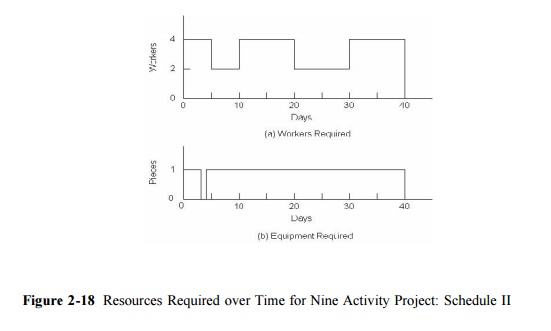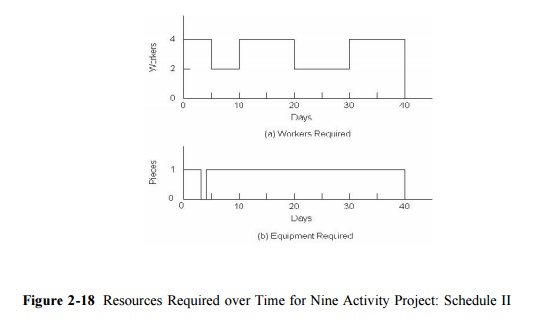Chapter: Civil : Construction Planning And Scheduling
Scheduling with Resource Constraints and Precedence

Scheduling
with Resource Constraints and Precedence
The previous section outlined resource oriented
approaches to the scheduling problem. In this section, we shall review some
general approaches to integrating both concerns in scheduling.
Two problems arise in developing a resource
constrained project schedule. First, it is not necessarily the case that a
critical path schedule is feasible. Because one or more resources might be
needed by numerous activities, it can easily be the case that the shortest
project duration identified by the critical path scheduling calculation is
impossible. The difficulty arises because critical path scheduling assumes that
no resource availability problems or bottlenecks will arise. Finding a feasible
or possible schedule is the first problem in resource constrained scheduling.
Of course, there may be a numerous possible schedules which conform with time
and resource constraints. As a second problem, it is also desirable to
determine schedules which have low costs or, ideally, the lowest cost.
Numerous heuristic methods have been suggested for
resource constrained scheduling. Many begin from critical path schedules which
are modified in light of the resource constraints. Others begin in the opposite
fashion by introducing resource constraints and then imposing precedence
constraints on the activities. Still others begin with a ranking or classification
of activities into priority groups for special attention in scheduling. One
type of heuristic may be better than another for different types of problems.
Certainly, projects in which only an occasional resource constraint exists
might be best scheduled starting from a critical path schedule. At the other
extreme, projects with numerous important resource constraints might be best
scheduled by considering critical resources first. A mixed approach would be to
proceed simultaneously considering precedence and resource constraints.
A simple modification to critical path scheduling
has been shown to be effective for a number of scheduling problems and is
simple to implement. For this heuristic procedure, critical path scheduling is
applied initially. The result is the familiar set of possible early and late
start times for each activity. Scheduling each activity to begin at its
earliest possible start time may result in more than one activity requiring a
particular resource at the same time. Hence, the initial schedule may not be
feasible. The heuristic proceeds by identifying cases in which activities
compete for a resource and selecting one activity to proceed. The start time of
other activities are then shifted later in time. A simple rule for choosing
which activity has priority is to select the activity with the earliest CPM
late start time (calculated as LS(i,j) = L(j)-Dij) among those
activities which are both feasible (in that all their
precedence requirements are satisfied) and competing for the resource. This
decision rule is applied from the start of the project until the end for each
type of resource in turn.
The order in which resources are considered in
this scheduling process may influence the ultimate schedule. A good heuristic
to employ in deciding the order in which resources are to be considered is to
consider more important resources first. More important resources are those
that have high costs or that are likely to represent an important bottleneck
for project completion. Once important resources are scheduled, other resource
allocations tend to be much easier. The resulting scheduling procedure is
described in Table 2-14.
The late start time heuristic described in Table 2-14 is only
one of many possible scheduling rules. It has the advantage of giving priority
to activities which must start sooner to finish the project on time. However,
it is myopic in that it doesn't consider trade-offs among resource types nor
the changes in the late start time that will be occurring as activities are
shifted later in time. More complicated rules can be devised to incorporate
broader knowledge of the project schedule. These complicated rules require
greater computational effort and may or may not result in scheduling
improvements in the end.
Example 2
-10: Additional resource constraints.
As another example, suppose that only one piece of equipment
was available for the project. As seen in Figure 2-17, the original schedule
would have to be significantly modified in this case. Application of the
resource constrained scheduling heuristic proceeds as follows as applied to the
original project schedule:
1. On day 4,
activities D and C are both scheduled to begin. Since activity D has a larger
value of late start time, it should be re-scheduled.
2. On day
12, activities D and E are available for starting. Again based on a later value
of late start time (15 versus 13), activity
D is deferred.
3. On day
21, activity E is completed. At this point, activity D is the only feasible
activity and it is scheduled for starting.
4. On day
28, the planner can start either activity G or activity H. Based on the later
start time heuristic, activity G is chosen to start.
5. On
completion of activity G at day 30, activity H is scheduled to begin.
The resulting profile of resource use is shown in Figure
10-18. Note that activities F and I were not considered in applying the
heuristic since these activities did not require the special equipment being
considered. In the figure, activity I is scheduled after the completion of
activity H due to the requirement of 4 workers for this activity. As a result,
the project duration has increased to 41 days. During much of this time, all
four workers are not assigned to an activity. At this point, a prudent planner
would consider whether or not it would be cost effective to obtain an
additional piece of equipment for the project.

Related Topics